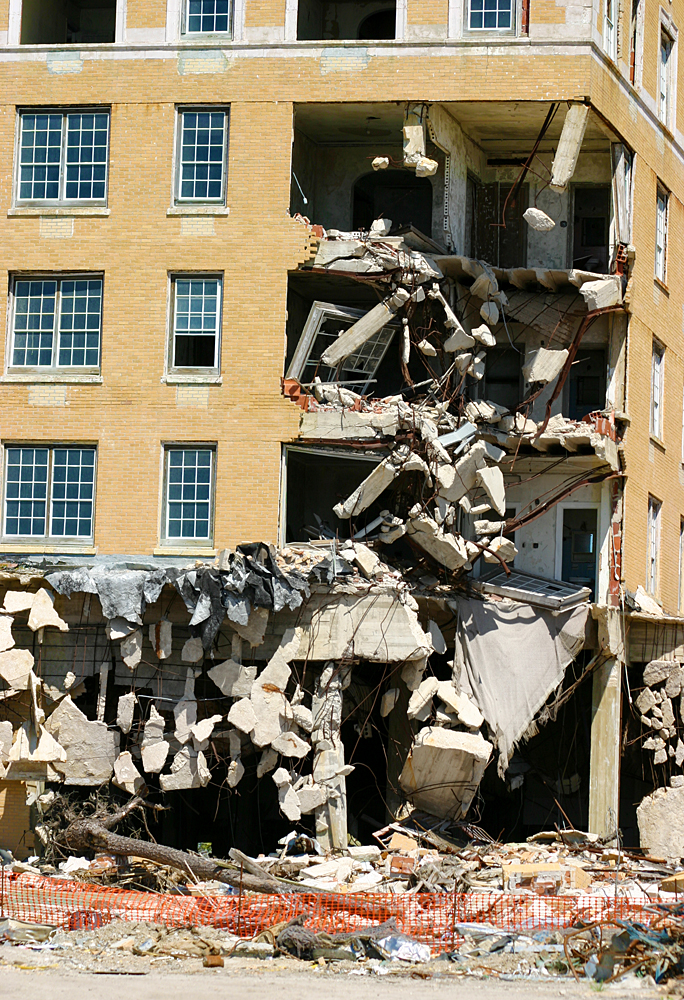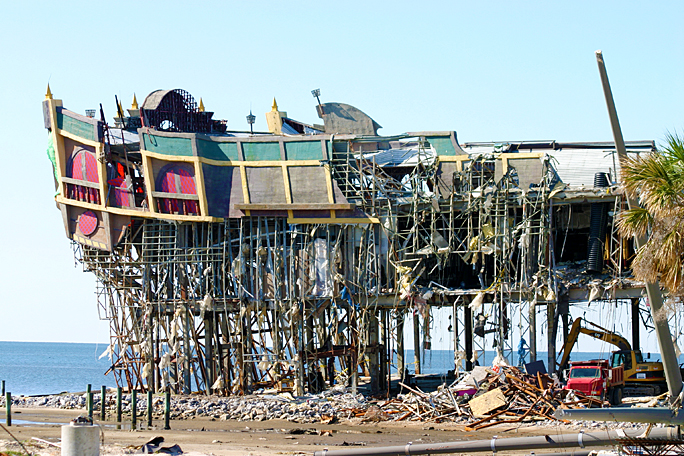A s I walked along the beach in Biloxi back in September of 2005 where casinos, restaurants, hotels and souvenir shops once stood, there was a flurry of activity. Workers clearing out buildings; bucket loaders and other heavy-duty construction equipment manned by their operators scooping mounds of refuse and loading them onto dump trucks whose drivers carted the trash away; reporters — such as Stephanie Abrams of The Weather Channel, who was standing on the beach in a lightweight blue parka out in the sunshine — broadcasted the latest on the progress of the recovery efforts.
Ironically — in part due to the devastation caused by Hurricane Camille on Sunday, August 17, 1969 — the tourist industry of the Mississippi Gulf Coast still had not recovered as late as the 1980s; so interest increased for the gambling industry to return to Mississippi on a limited basis where the gambling could only occur at dockside on the Gulf of Mexico and in waterways such as the Mississippi River.
Members of the Mississippi Legislature passed the Mississippi Gaming Control Act on Friday, June 29, 1990, which stated that casino gambling was allowed only in counties along the Mississippi River and along the Mississippi Gulf Coast — provided that the voters who were based in those eligible areas approved it. The casinos had to be able to float out to sea in the event of a natural disaster such as Hurricane Katrina, which tested that provision. That obviously did not work, as the photographs shown below illustrate.
Today, casinos are now permitted to be built on land within a certain distance of water; but let us go back in time to September of 2005.

Once a Sheraton hotel, the Treasure Bay Casino and Hotel building shown above — which was significantly damaged by Hurricane Katrina — was renovated and is still in use today.

The casino portion of Treasure Bay was housed in a replica of a pirate ship.

The pirate ship was so substantially damaged by Hurricane Katrina that it was eventually demolished.

The building in the photograph shown below was also irreparable…

…so it was demolished as well.






Mounds upon mounds of refuse were still piling up and waiting to be collected and taken away.


Heavy equipment was needed to remove all of the refuse.


The Tivoli Hotel — also known as the Trade Winds Hotel and was once a luxury hotel which became a landmark — was so severely damaged when a casino barge ran aground into it during Hurricane Katrina that it could not be saved.

It was demolished in May of 2006.

The Beauvoir estate was the former home of Jefferson Davis after the conclusion of the Civil War of the United States. Parts of it had just been restored prior to the unwelcome arrival of Hurricane Katrina. Greater than a third of the collections housed within Beauvoir are forever lost; but Beauvoir itself was restored and once again opened to the public in June of 2008.

Officially dedicated on Wednesday, July 19, 1905, St. Thomas the Apostle Catholic Church in Long Beach was already ravaged by both the hurricane of 1947 and by Hurricane Camille before landfall on Sunday, August 17, 1969.

The church once again sustained substantial damage when confronted with the brunt brute forces of Hurricane Katrina…

…but it was eventually rebuilt yet again and thrives to this day.

New Orleans may have received much of the attention today on the tenth anniversary of the arrival of Hurricane Katrina to the gulf coast of the United States; but the stalwart residents of the Mississippi Gulf Coast had proven their resiliency to the worst of whatever comes their way — and their determination and persistence deserves accolades, in my opinion.
All photographs ©2005 by Brian Cohen.

